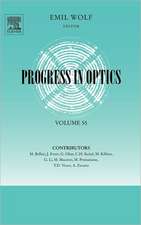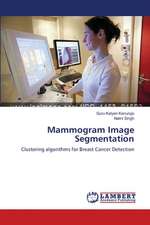Vision with Direction: A Systematic Introduction to Image Processing and Computer Vision
Autor Josef Bigunen Limba Engleză Paperback – 12 feb 2010
| Toate formatele și edițiile | Preț | Express |
|---|---|---|
| Paperback (1) | 338.16 lei 6-8 săpt. | |
| Springer Berlin, Heidelberg – 12 feb 2010 | 338.16 lei 6-8 săpt. | |
| Hardback (1) | 346.56 lei 6-8 săpt. | |
| Springer Berlin, Heidelberg – 9 feb 2006 | 346.56 lei 6-8 săpt. |
Preț: 338.16 lei
Preț vechi: 422.70 lei
-20% Nou
Puncte Express: 507
Preț estimativ în valută:
64.72€ • 66.70$ • 54.64£
64.72€ • 66.70$ • 54.64£
Carte tipărită la comandă
Livrare economică 03-17 martie
Preluare comenzi: 021 569.72.76
Specificații
ISBN-13: 9783642066061
ISBN-10: 3642066062
Pagini: 412
Ilustrații: XV, 396 p.
Dimensiuni: 155 x 235 x 22 mm
Greutate: 0.58 kg
Ediția:Softcover reprint of hardcover 1st ed. 2006
Editura: Springer Berlin, Heidelberg
Colecția Springer
Locul publicării:Berlin, Heidelberg, Germany
ISBN-10: 3642066062
Pagini: 412
Ilustrații: XV, 396 p.
Dimensiuni: 155 x 235 x 22 mm
Greutate: 0.58 kg
Ediția:Softcover reprint of hardcover 1st ed. 2006
Editura: Springer Berlin, Heidelberg
Colecția Springer
Locul publicării:Berlin, Heidelberg, Germany
Public țintă
GraduateCuprins
Human and Computer Vision.- Neuronal Pathways of Vision.- Color.- Linear Tools of Vision.- Discrete Images and Hilbert Spaces.- Continuous Functions and Hilbert Spaces.- Finite Extension or Periodic Functions—Fourier Coefficients.- Fourier Transform—Infinite Extension Functions.- Properties of the Fourier Transform.- Reconstruction and Approximation.- Scales and Frequency Channels.- Vision of Single Direction.- Direction in 2D.- Direction in Curvilinear Coordinates.- Direction in ND, Motion as Direction.- World Geometry by Direction in N Dimensions.- Vision in Multiple Directions.- Group Direction and N-Folded Symmetry.- Grouping, Segmentation, and Region Description.- Reducing the Dimension of Features.- Grouping and Unsupervised Region Segregation.- Region and Boundary Descriptors.- Concluding Remarks.
Notă biografică
A fellow of the Institute of Electrical and Electronic Engineering (IEEE) and the International Association for Pattern Recognition (IAPR), Josef Bigun obtained his Ms and Ph.D. degrees from Linkoping University, Sweden, in 1983 and 1988 respectively. In 1988, he joined the Swiss Federal Institute of Technology in Lausanne where he worked as Adjoint Scientifique until 1998 with the exception that in 1997 he was a visiting professor at the Royal Institute of Technology, (KTH) Stockholm. He has been elected professor to the Signal Analysis Chair, his current position, at Halmstad University and Chalmers Institute of Technology in 1998.
He has been in technical and organizational committees of numerous national and international conferences. In particular, he co-chaired the First International Conference on Audio and Video Based Person Authentication in 1997. He has been contributing as a referee or as an editorial board member of international journals including Pattern Recognition Letters and IEEE Image Processing. He has contributed to the initiation and progress of several national and international research projects in computer vision, in particular in biometric person authentication, e.g. the EU projects IT-VIRSBS, ACTS-M2VTS, NOE-BIOSECURE.
He has been in technical and organizational committees of numerous national and international conferences. In particular, he co-chaired the First International Conference on Audio and Video Based Person Authentication in 1997. He has been contributing as a referee or as an editorial board member of international journals including Pattern Recognition Letters and IEEE Image Processing. He has contributed to the initiation and progress of several national and international research projects in computer vision, in particular in biometric person authentication, e.g. the EU projects IT-VIRSBS, ACTS-M2VTS, NOE-BIOSECURE.
Caracteristici
Systematic classroom-tested introduction to computer vision and image processing Four-color illustrations throughout the book Based on the novel concept of generalized structure tensors, this book develops a mathematically rigor theory of computer vision Includes supplementary material: sn.pub/extras













